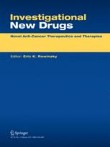|
Medicine RSS-Feeds by Alexandros G. Sfakianakis,Anapafseos 5 Agios Nikolaos 72100 Crete Greece,00302841026182,00306932607174,alsfakia@gmail.com
Πληροφορίες
Κυριακή 13 Δεκεμβρίου 2020
Ender 3 - extruder stepper skipping
Drug repurposing using transcriptome sequencing and virtual drug screening in a patient with glioblastoma
|
Prognostic Significance of Pain in Parotid Gland Malignancy
|
Oil pulling to relieve medication‐induced xerostomia: a randomized, single‐blind, crossover trial
|
In‐depth analysis of thyroid cancer mortality
|
Definitive intensity‐modulated radiotherapy or surgery for early oral cavity squamous cell carcinoma: Propensity‐score‐matched, nationwide, population‐based cohort study
|
primary salivary gland tumors in pediatric
|
A novel temporal‐predominant neuro‐astroglial tauopathy associated with TMEM106B gene polymorphism in FTLD/ALS‐TDP
|
Advanced age heightens hepatic damage in a murine model of scald burn injury
|
Fast Track Pathway Provides Safe, Value Based Care on Busy Acute Care Surgery Service
|
TRAUMA PATIENT TRANSPORT TIMES UNCHANGED DESPITE TRAUMA CENTER PROLIFERATION: A 10 YEAR REVIEW
|
Provisional Minifragment Plate Fixation of Acetabular Fractures—A Technical Trick
|
Αρχειοθήκη ιστολογίου
-
►
2023
(366)
- ► Φεβρουαρίου (184)
- ► Ιανουαρίου (182)
-
►
2022
(2814)
- ► Δεκεμβρίου (182)
- ► Σεπτεμβρίου (213)
- ► Φεβρουαρίου (264)
- ► Ιανουαρίου (262)
-
►
2021
(3815)
- ► Δεκεμβρίου (229)
- ► Σεπτεμβρίου (276)
- ► Φεβρουαρίου (64)
-
▼
2020
(5754)
-
▼
Δεκεμβρίου
(401)
-
▼
Δεκ 13
(25)
- Ender 3 - extruder stepper skipping
- Drug repurposing using transcriptome sequencing an...
- Prognostic Significance of Pain in Parotid Gland M...
- Oil pulling to relieve medication‐induced xerostom...
- In‐depth analysis of thyroid cancer mortality
- Definitive intensity‐modulated radiotherapy or sur...
- primary salivary gland tumors in pediatric
- A novel temporal‐predominant neuro‐astroglial tauo...
- Advanced age heightens hepatic damage in a murine ...
- Fast Track Pathway Provides Safe, Value Based Care...
- TRAUMA PATIENT TRANSPORT TIMES UNCHANGED DESPITE T...
- Provisional Minifragment Plate Fixation of Acetabu...
- Surgical Dislocation or the Modified Heuter Anteri...
- Ἡ πανδημία χρησιμοποιεῖται ὡς πρόσχημα
- Best way to assemble moving parts of robot arm gri...
- Κύκκου Νικηφόρος: «Μεγάλο ατόπημα το κλείσιμο των ...
- Τα μέτρα για τον κορωναϊό υποβαθμίζουν και προσβάλ...
- Εν όψει των Χριστουγέννων… (2)
- Владика Јоаникије богослужио у манастиру Ђурђеви С...
- Can't get bed to level for my life
- Γένεση κατά την Στωική κοσμογονία
- A Phase 1 study of RO6870810, a novel bromodomain ...
- Transcriptional factor ATF3 promotes liver fibrosi...
- Regulation of melanoma malignancy by the RP11-705C...
- Effect of frenotomy on breastfeeding and reflux: r...
-
▼
Δεκ 13
(25)
- ► Σεπτεμβρίου (365)
- ► Φεβρουαρίου (754)
- ► Ιανουαρίου (894)
-
▼
Δεκεμβρίου
(401)
-
►
2019
(146)
- ► Δεκεμβρίου (19)
- ► Σεπτεμβρίου (54)





